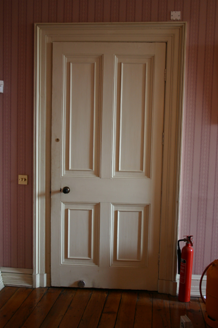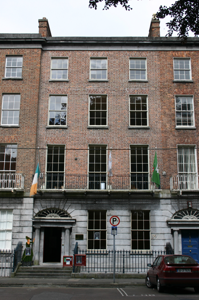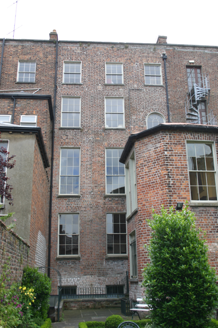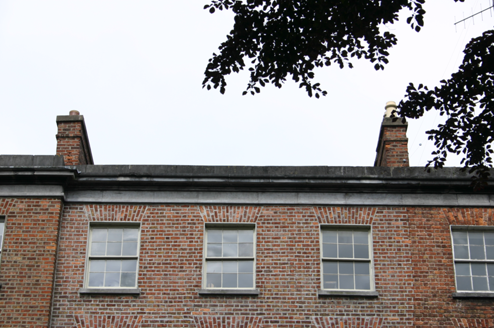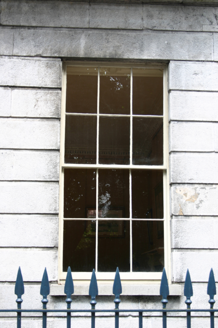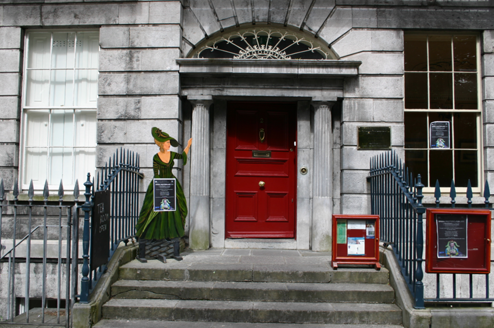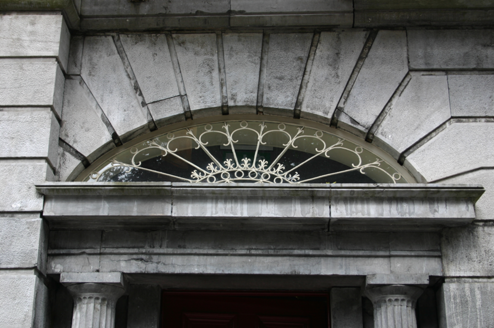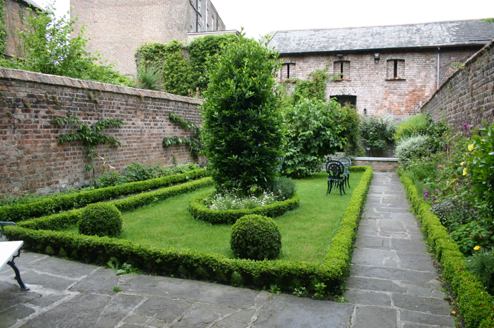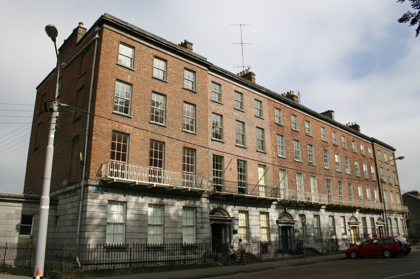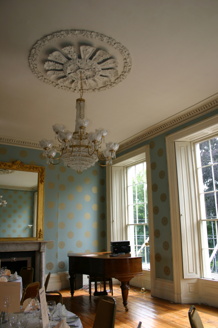Survey Data
Reg No
21517183
Rating
National
Categories of Special Interest
Architectural, Artistic, Historical
Original Use
House
In Use As
Museum/gallery
Date
1835 - 1840
Coordinates
157425, 156481
Date Recorded
09/08/2005
Date Updated
--/--/--
Description
Terraced three-bay four-storey over basement house, built between 1835-38, forming part of a terrace collectively referred to as the Tontine Building, which forms a grand composition of six houses, each of which is unified by a number of architectural features including a rusticated limestone ashlar ground floor elevation, a wrought-iron balcony, fenestration alignment and limestone ashlar parapet entablature. Two-bay two-storey return to rear with chamfered corners. Roof structure concealed behind a parapet wall to front and rear elevation. Red brick chimneystack with plain clay pots of recent origins, rise from the party wall to north and south. Tooled limestone ashlar basement elevation terminating at ground floor level with a smooth limestone ashlar plinth course above which a channel rusticated limestone ashlar elevation articulates the ground floor; first, second and third floor elevations are faced in red brick laid in Flemish bond with cement repointing. Limestone ashlar parapet entablature. Red brick faced rear elevation laid in Flemish bond, with cement repointing; limestone coping to parapet wall. Square-headed window openings to front and rear, with red brick flat arches (limestone lintels and reveals to ground floor openings of façade), patent rendered reveals, limestone sills, and six-over-six timber sash windows to ground second and third floor level, nine-over-six to first floor level. Round-arched stair hall window opening evident between first and second floor level to rear elevation with red brick arches and six-over-six timber sash windows with fanlighted upper sash. Three-centred arch doorcase comprising three-quarters engaged Doric columns, with two-thirds fluted shafts, joined by plain entablature; elaborate radiating fanlight; plain limestone ashlar door architrave with early bell ringer, limestone threshold step, and flat-panelled timber door with horizontal central panel and brass door furniture. Limestone flagged front door area arrived at by a flight of limestone steps. Front site enclosed from pavement by limestone plinth wall supporting wrought-iron railings with spear-head finials. Original square-plan coal hole cover set in limestone flag with Neoclassical radiating ovals to four corners and the letters PS [Pery Square] to centre. Red brick wall divides rear site from No. 2 with red brick coping. Coach house terminating rear site forming three-bay two-storey red brick faced garden elevation; camber-arched window openings to first floor level, partially blind with narrow vent opening and brick sills. Built within a standard Georgian townhouse floor plan with piano nobile to first floor level accessed by primary staircase, axially placed to the entrance hall and rising to second floor level. Extensively restored with much of the original joinery and plasterwork conserved. Restored as a museum piece with reproduction historic wallpaper to principal drawing rooms and bedrooms. Many historically accurate marble chimneypieces with a range of grates including a pewter grate, a Regency brass grate, and ornate Victorian cast-iron register grates. Restoration of fine marbleised entrance hall and stair hall adding the Neo-classical character of the interior. Original staircase comprising slender turned timber balusters on a pear-shaped base with mahogany handrail terminating with a curtail step; open string with scrolled tread ends. Secondary stairs to basement level with paired Doric newels at junction with ramped hand rail and plain timber balusters. Secondary stairs to third floor level accessed from landing at second floor level.
Appraisal
Formerly the residence of Michael Gavin (between 1840-1850), who sold his house (George's Street, now O'Connell Street) to the Chamber of Commerce. The terrace was constructed as a speculative development by the Pery Square Tontine Company which had as its members in 1836, Alderman Henry Watson (Chair), Captain H.M. Ryves, Thomas P. Vokes, C.M.P. Alderman D.F.G. Mahony, Wm. Piercy, Edward Homan, Henry Owens, James Pain, Piens Creagh, Mat. And Dan. Barrington, Esqrs., and Hon. E.S. Pery. The architect James Pain supervised the construction of the terrace and may well have been responsible for the design. The contractor was Pierse Creagh, Ennis. By 1838, the houses forming this terrace were let to tenants.
